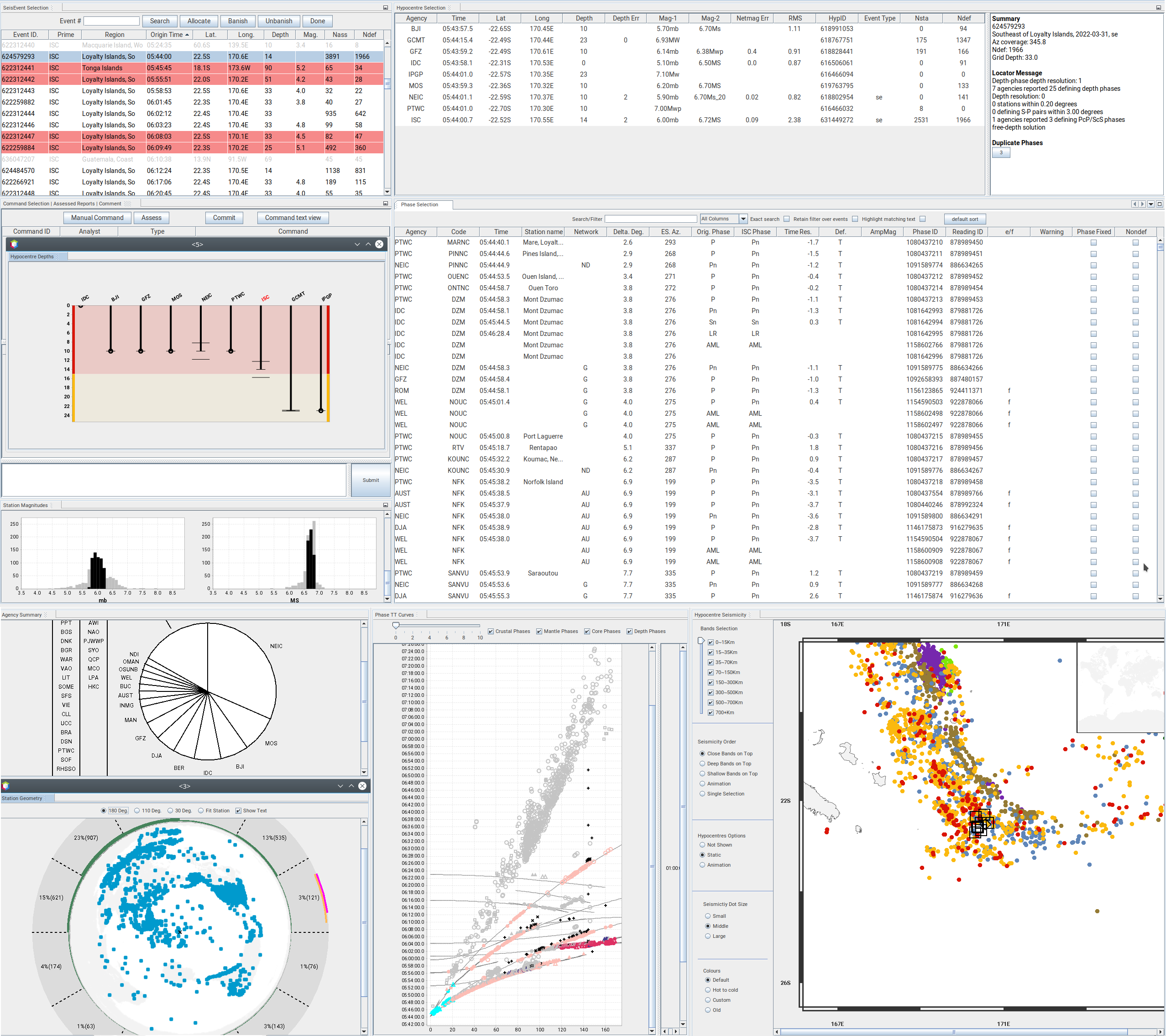Reviewed ISC Bulletin
Review procedure

Visual Bulletin Analysis System (VBAS) developed at the ISC used for the Bulletin review. Top left, clockwise: List of events, list reported hypocentres for chosen event, event summary (e.g. locator message, azimuthal coverage etc.), reported phase arrivals, seismicity map, travel time curve, station distribution, reporting agencies, magnitude histograms and depth distribution of reported hypocentres.
Typically, for each month, the ISC analysts now review approximately 10-20% of the events in the ISC database, currently 3,500-5,000 per data month. This review is done about 24 months behind real time to allow for the comprehensive collection of data from networks and data centres worldwide.
Users of the ISC Bulletin can be assured that all ISC Bulletin events with an ISC hypocentre solution have been reviewed by the ISC analysts. Not all reviewed events will end up having an ISC hypocentre solution, but events that have not been reviewed are flagged accordingly.
An automatic algorithm decides which events in the ISC database merit a review by the ISC Analysts. The decision is based on M, which is the maximum of all network magnitudes reported for a given seismic event.
- either hypocentre or arrival data reported by more than one network and
- neither station network alone has an acceptable station configuration and
- a cumulative set of stations reported this event to the ISC considerably improves network geometry as compared to any single network.
If M is unknown, the number of data sources of hypocentres and phase arrivals is used as well as the maximum epicentral distance of arrival data. Typically this is two reporters and ten degrees of distance.
The events that need to be reviewed are split into daily blocks on average consisting of 100 – 150 events. They are then analysed and if necessary edited by an analyst. After all blocks in a data month have been reviewed, they are being assessed again by a different analyst to spot any potential inconsistencies that might have been overlooked in the first run.
Analysis is done with the help of the Visual Bulletin Analysis System (VBAS) developed at the ISC. For each event it shows the reported hypocentres, magnitudes and phase arrivals as well as an ISC solution for the hypocentre, if there is one, along with phase arrival-time residuals and error estimates. Amongst other visual aids, VBAS plots graphs of travel time curves, seismicity maps, depth distributions of reported hypocentres and station geometry.
The analysts have the capability to execute a variety of commands that can be used to merge or split events, to move phase arrivals or hypocentres from one event to another or to modify the reported phase names. There are also several commands to change the starting depth or location in the location algorithm.
The main tasks in reviewing the ISC Bulletin are to:- Check that the grouping of hypocentres and association of phase arrivals is appropriate.
- Check that the depth and location is appropriate for the region and reported phase arrivals.
- Check that no data are missing for an event, given the region and magnitude, and that included data are appropriate.
- Examine the phase arrival-time residuals to check that the ISC hypocentre solution is appropriate.
- Look for outliers in the observations and for misassociated phases.
- Check that the station azimuthal coverage for ISC hypocentres is at least 45 deg.
As well as examining each event closely, it is also important to scan the hypocentres and phase arrivals of adjacent events, close in time and space, to ensure that there is uniformity in the composition of the events. In some cases, two events should be merged into one event, as apparent in some other case. In other cases, one apparent event needs to be split into two events, when the automatic grouping has erroneously created one event with more than one reported hypocentre out of the observations for two real events that are distinct but closely occurring.
Misassociated phase arrivals are returned to the unassociated data stream, if not immediately placed by the analyst in another event where they belong. These unassociated phases are then available to be associated with some other event if the time and location is appropriate. The analysts also check that no phase is associated to more than one event.
Towards the end of the monthly analysis, the ISC ‘Search’ procedure runs, attempting to build events from the remaining set of unassociated phase arrivals. The algorithm is based on the methodology of Engdahl and Gunst (1966). Candidate events are validated or rejected by attempting to find ISC hypocentres for them using the ISC locator. The surviving events are then reviewed. Those events with phase arrival observations reported by stations from at least two networks are added to the ISC Bulletin if the solutions meet the standards set by the ISC analysts. These events have only an ISC hypocentre.
At the end of analysis for a data month, a set of final checks is run for quality control, with the results reviewed by an analyst and the defects rectified. These are checks for inconsistencies and errors to ensure the general integrity of the ISC Bulletin.
More information on the operational procedures of the ISC can be found in the Appendix of the Summary of the Bulletin of the International Seismological Centre [http://publications.isc.ac.uk] (available in the first issue of each year).
References
Engdahl, E.R. and R.H. Gunst, 1966. Use of a high speed computer for the preliminary determination of earthquake hypocenters, Bull. Seism. Soc. Am., 56, 325-336.https://doi.org/10.1785/BSSA0560020325.

